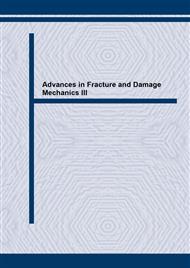[1]
R. Adams and W. Wake, Structural Adhesive Joints in Engineering (Elsevier, 1984).
Google Scholar
[2]
M.M. Abdel Wahab, I. A. Ashcroft, A.D. Crocombe and P.A. Smith, International Journal of Fatigue, Vol. 24(6) (2002), pp.705-709.
Google Scholar
[3]
M.M. Abdel Wahab, Journal of Adhesion Science and Technology, Vol. 14(6) (2002), pp.851-866.
Google Scholar
[4]
C.T. Sun and C.J. Jih, Engineering Fracture Mechanics, Vol. 28(1) (1987), pp.13-20.
Google Scholar
[5]
A.D. Crocombe, C.Y. Ong, C.M. Chan, M.M. Abdel Wahab and I.A. Ashcroft, Journal of Adhesion, Vol. 78(9) (2002), pp.745-778.
Google Scholar
[4]
4. 5 3 3. 5 4 4. 5 5 5. 5 6 6. 5 log cycles to failure Maximum load (kN) Experimental (no fillet) Experimental (fillet) nGI nGT.
Google Scholar
[2] [4] [6] [8] [10] [12] 143. 5 4 4. 5 5 5. 5 6 6. 5 log cycles to failure Maximum load (kN) Experimental nGI nGT.
Google Scholar


